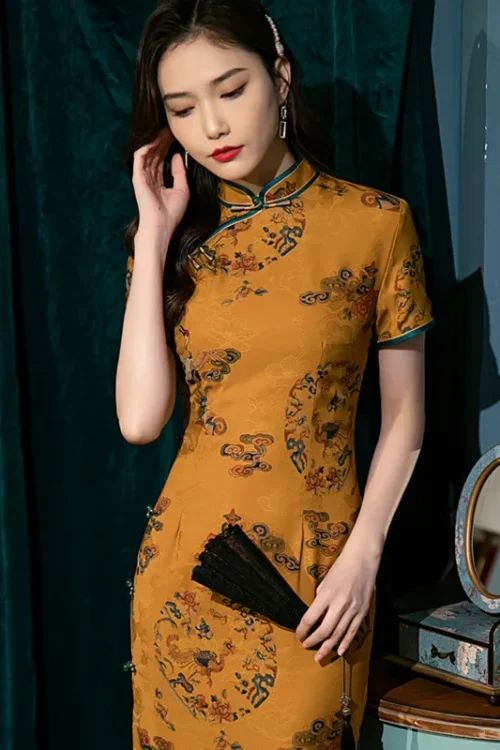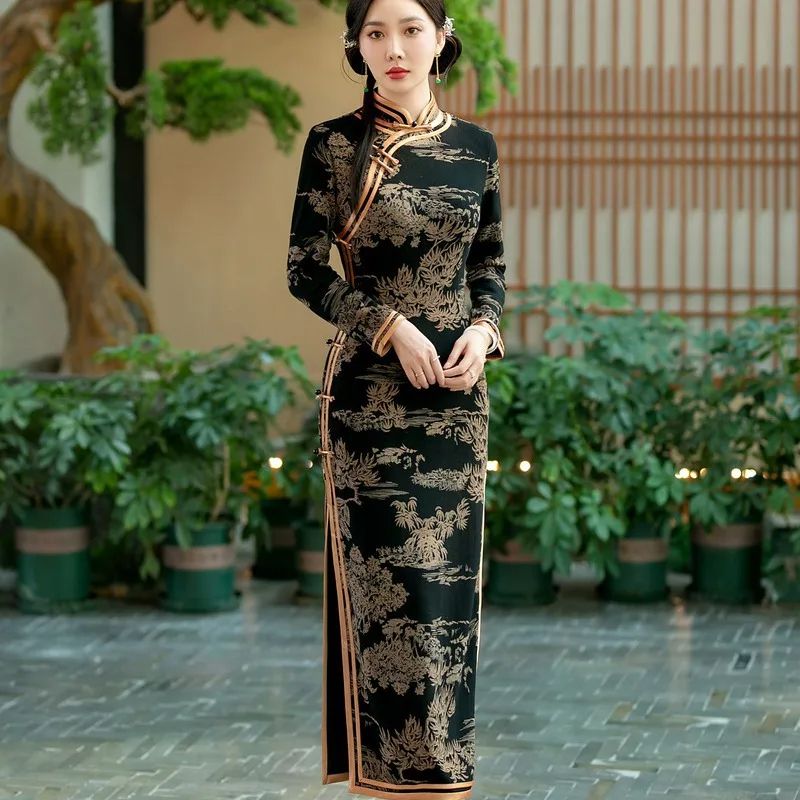The modern qipao, or cheongsam, is an iconic symbol of Chinese culture and fashion. This elegant attire, recognized for its sleek, figure-hugging silhouette and rich detailing, embodies the perfect blend of tradition and modernity. Yet, behind this timeless garment lies a complex history filled with cultural significance and evolution.
旗袍 vs. 旗袍: A Linguistic and Cultural Perspective
The terms “qipao” and “cheongsam” are often used interchangeably, but they hold distinct regional meanings. “Cheongsam” derives from the Cantonese word for long dress, while “qipao” is its Mandarin equivalent. In Hong Kong, the term “cheongsam” can refer to both men’s 和 women’s clothing, whereas “qipao” in Mandarin is used exclusively for women’s attire. Despite these nuances, both terms represent a garment deeply rooted in Chinese history and fashion.

Tracing the Qipao’s Historical Roots
The qipao’s origins date back to the Qing Dynasty (1636-1911), when it was traditionally worn by the Manchu people. During this time, both men and women wore long, loose-fitting robes, with the qipao becoming a symbol of status and elegance among the Manchu court. It wasn’t until the early 20th century, particularly between 1920 and 1940 in Shanghai, that the qipao began to take on its more modern form—slimmer, more fitted, and infused with elements of femininity and grace.
The Qipao’s Evolution through Time
The Qing Dynasty version of the qipao was a flowing garment, often adorned with intricate embroidery and a modest silhouette. However, the early 20th century brought significant changes to its design. As Western influences crept into Chinese fashion, the qipao began to adopt a more form-fitting shape, higher slits, and luxurious fabrics, marking a shift towards the stylish and feminine look we recognize today.
The Modern Qipao: A Fashion Staple for Special Occasions
While the qipao was once daily attire, it is now reserved for formal events such as weddings, festivals, and other special occasions. Its enduring elegance has made it a favorite for these events, with modern interpretations featuring everything from school uniforms to professional wear in sectors such as hospitality and aviation. Whether worn for a Chinese New Year celebration or an international fashion event, the qipao stands as a proud symbol of Chinese cultural identity.
The Transformation of the Qipao: From Tradition to Modern Luxury
The qipao’s journey from its loose-fitting origins in the Qing Dynasty to the modern, sleek version seen today is a testament to its adaptability. The early qipao covered the body modestly, leaving only the head, hands, and feet exposed, while the modern qipao accentuates the figure with a closer fit, shorter length, and elegant slits.

The qipao experienced a revival during the 1920s and 1930s in Shanghai, becoming the go-to attire for celebrities and social elites. Figures like Madame Wellington Koo played a crucial role in popularizing the modern qipao by shortening its length and selecting only the finest silk fabrics. By the mid-20th century, Western fashion trends, including stockings and high-heeled shoes, began influencing the qipao’s design, adding new layers of sophistication to this traditional garment.
Madame Wellington Koo: A Fashion Icon
A major figure in the qipao’s history, Madame Wellington Koo was one of Vogue’s best-dressed women of 1942. She modernized the qipao by shortening its length and adding luxurious details. Her influence helped make the qipao a symbol of glamour and sophistication, both in China and abroad.
The Decline and Resurgence of the Qipao
After 1949, the qipao’s popularity waned in mainland China due to political changes and the drive towards modernization. However, in Hong Kong, the qipao continued to thrive well into the 1950s. The garment has since made a comeback, both in China and globally, embraced by fashion designers and seen on runways around the world.
The Evolution of Qipao Design
As the qipao evolved, its design began incorporating Western elements. The qipao of the 1940s featured bold changes such as sleeveless designs, bell sleeves, and various fabrics, offering a range of options for different occasions. Today, the qipao is available in diverse styles, from short, playful dresses to mid-length versions with lace embroidery, catering to a wide variety of fashion preferences.
When to Wear a Qipao: Celebrating Elegance on Every Occasion
The qipao is a versatile garment that can be worn for a wide range of occasions. Historically, Chinese women wore the qipao as everyday attire, especially during the Qing Dynasty. By the 1920s in Shanghai and the 1950s in Hong Kong, it had transitioned into casual wear, representing a harmonious blend of tradition and modernity.

Today, the qipao is worn for:
- Weddings: The qipao remains a favorite for Chinese wedding ceremonies, often worn by brides with Chinese heritage or those marrying into Chinese families.
- School Uniforms: In certain Hong Kong schools, especially Christian or Catholic institutions, the qipao is still worn as a school uniform.
- Professional Wear: Many restaurants, hotels, and airlines in China, Taiwan, and regions like Singapore feature the qipao as uniforms, symbolizing elegance and professionalism.
- Festivals and Celebrations: The qipao is a popular choice for Chinese New Year and other cultural festivals, embodying the essence of traditional Chinese values.
- Global Fashion Events: The qipao has been embraced by designers worldwide and has been featured in Hollywood films, worn by stars like Maggie Cheung, Michelle Yeoh, and Anne Hathaway.
Styling the Modern Qipao
To make the most of the modern qipao, consider these style tips:
- Choose a flattering collar: Pick a collar that complements your neckline and enhances your overall look.
- Accessorize smartly: Pair your qipao with stylish accessories to add a modern twist.
- Explore sleeve options: Sleeveless qipaos can create a leaner appearance for the arms.
- Select the right fabric: Opt for high-quality, wrinkle-free fabrics to ensure your qipao stays elegant all day.
The modern qipao is a perfect fusion of tradition and contemporary fashion, a timeless garment that continues to celebrate Chinese culture while adapting to the ever-changing world of style.
